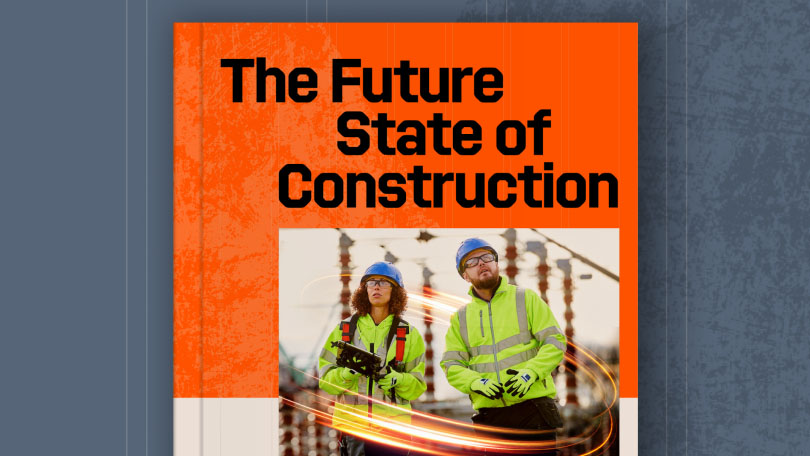— 6 min read
Construction Site Logistics: Keeping Projects Moving


Last Updated Aug 28, 2025

Nicholas Dunbar
Content Manager
62 articles
Nick Dunbar oversees the creation and management of UK and Ireland educational content at Procore. Previously, he worked as a sustainability writer at the Building Research Establishment and served as a sustainability consultant within the built environment sector. Nick holds degrees in industrial sustainability and environmental sciences and lives in Camden, London.

Zoe Mullan
27 articles
Zoe Mullan is an experienced content writer and editor with a background in marketing and communications in the e-learning sector. Zoe holds an MA in English Literature and History from the University of Glasgow and a PGDip in Journalism from the University of Strathclyde and lives in Northern Ireland.
Last Updated Aug 28, 2025

Construction projects demand precise coordination of countless moving parts. Materials must arrive on time, workers need proper scheduling, and equipment requires careful placement. Construction logistics orchestrates this complex operation, ensuring every project flows smoothly from start to finish.
Projects without effective logistics planning face inevitable delays, cost overruns, and safety risks. Understanding how construction site logistics works – and why it matters – helps every stakeholder deliver successful builds.
Table of contents
What Construction Site Logistics Delivers
Construction site logistics encompasses the planning, coordination, and management of all on site resources. This includes materials, equipment, and labour – covering how and when teams deliver, store, move, and use these resources throughout the project lifecycle.
Poor logistics planning creates significant problems. Supply bottlenecks emerge, machinery sits idle, and work zones become congested. In contrast, effective logistics keeps projects moving forward and significantly impacts four critical areas:
Project Timelines
Teams minimise delays and keep critical-path activities on track.
Safety
Reduced site congestion and better coordination prevent accidents.
Optimised workflows cut waste, avoid downtime, and improve efficiency.
Site Productivity
Workers complete tasks without unnecessary disruption.
While logistics forms a crucial component of project success, it works alongside other critical factors, including project management, design quality, financial management, and external conditions. Poor logistics can certainly derail well-designed projects, but effective logistics planning helps teams maintain momentum, avoid disruption, and deliver projects safely within budget.
Essential Site Logistics Components
Managing construction site logistics requires balancing strategic planning with ongoing execution. The following components work together to support smooth, efficient logistics throughout any build:
Strategic Planning
A detailed logistics plan forms the foundation for project success. It maps out material deliveries and site movement, including layout design, delivery schedules, and access routes.
Stakeholder Coordination
Clear communication across all parties reduces misunderstandings and errors. This means coordinating subcontractors, suppliers, and local authorities to ensure everyone aligns with the logistics strategy, avoiding clashes or delays.
Material Management
Effective logistics depends on accurate procurement, storage, and distribution. Managing inventory and deliveries reduces waste while guaranteeing required materials arrive at the right time.
Transport Planning
Large vehicle movements can halt a site – or nearby roads – without close coordination. Therefore, solid planning maintains safe access and prevents breaches of local transport regulations, particularly when managing restricted routes or over-dimensional loads.
Equipment Oversight
Ensuring the right equipment remains available, functional, and properly allocated improves site efficiency. This approach reduces downtime linked to breakdowns or misallocated items.
Workforce Coordination
Logistics must align with workforce needs. This involves scheduling optimal personnel at the right times, ensuring neither too many nor too few workers occupy the site while providing access to necessary tools, materials, and workspaces.
Safety and Compliance
A comprehensive logistics strategy maintains clear health and safety procedures and training while complying with evolving environmental regulations.
Continuous Monitoring
When the plan launches, teams must monitor progress continuously. Tracking KPIs like delivery accuracy, material-handling efficiency, and site flow helps teams adjust and improve performance in real time.
Key Logistics Benefits
Well-managed construction logistics unlocks major advantages across the entire project lifecycle, delivering safer, faster, and more cost-effective builds. These benefits include:
Fewer Delays
Teams avoid hold-ups caused by material shortages, equipment misplacement, or access issues.
Cost Savings
Optimised workflows and reduced waste cut unnecessary spending.
Enhanced Safety
Structured site movement and better coordination minimise congestion and risks.
Higher Productivity
Trades keep moving without downtime from poor sequencing or resource clashes.
Superior Outcomes
Projects deliver on time, within budget, and to required quality standards.
Construction Logistics Plans (CLPs)
A Construction Logistics Plan (CLP) outlines how teams will manage logistics on and around construction sites. As a mandatory requirement for many UK construction projects – particularly large urban developments – a CLP demonstrates how construction-related logistics will minimise disruption, reduce environmental impact, and improve safety for workers and surrounding communities.
A comprehensive CLP typically includes:
Aligning logistics milestones with construction programmes.
Resource Planning
Mapping labour, equipment, and material needs across all phases.
Site Design
Defining delivery zones, storage areas, pedestrian routes, and vehicle access.
Transport Coordination
Outlining delivery timings, vehicle types, and restrictions.
Safety Protocols
Documenting procedures aligned with health, safety, and environmental requirements.
Communication Frameworks
Establishing clear responsibilities and escalation routes.
Contingency Planning
Preparing for weather delays, supplier issues, or equipment breakdowns.
Performance Monitoring
Setting KPIs for logistics performance and compliance tracking.
In the UK, some CLPs are assessed against frameworks like CLOCS (Construction Logistics and Community Safety), which focuses primarily on safety and community impact rather than logistics performance. However, CLP requirements vary by local authority, and not all planning authorities use CLOCS as their assessment framework. Additional considerations often required as part of UK planning consent include:
- Traffic management plans to control site-related vehicle movements
- Permits and local authority compliance for deliveries and working hours
- Over-dimension load planning and permitting for oversized equipment
- Storage solutions for limited on site space in dense urban locations
- Site access coordination to prevent congestion and protect pedestrians
- Route planning using approved delivery routes to reduce disruption
- Electronic proof of delivery (ePOD) systems for tracking and reporting
Technology’s Growing Role in Construction Logistics
Technology increasingly supports construction site logistics management, helping teams plan smarter and monitor real-time progress. Digital logistics platforms enable teams to:
- Visualise site layouts and plan the movement of materials, equipment, and people
- Schedule and track deliveries with live updates and electronic proof of delivery
- Coordinate with suppliers and subcontractors through shared platforms
- Monitor logistics KPIs, including delivery accuracy and site congestion
- Automate workflows while reducing administration time and ensuring compliance
Adopting tools like digital delivery logs, GPS fleet tracking, and smart inventory management helps teams improve on site performance while supporting regulatory compliance. However, full compliance depends heavily on adherence to specific legal and regulatory standards – technology supports these requirements but does not solely fulfil them. These tools can support CLP requirements, particularly in projects where CLOCS frameworks or local traffic planning rules apply.
Managing Risks and Planning Contingencies
Even with solid logistics plans, construction projects remain vulnerable to disruption. Weather delays, equipment breakdowns, supply shortages, or road closures can quickly derail schedules and increase costs without proper preparation. Therefore, risk management and contingency planning are essential to construction logistics.
Effective risk management helps logistics teams:
- Identify potential risks early, from traffic restrictions to extreme weather
- Build in contingencies such as buffer times, alternative routes, or backup equipment
- Coordinate with suppliers and subcontractors on risk scenarios and mitigation protocols
- Review performance data regularly to identify weak points or recurring issues
In the UK, this proves especially important for urban sites with limited access, unpredictable traffic, and strict environmental or noise restrictions. Pre-planned contingencies also demonstrate compliance and due diligence to clients, regulators, planning authorities, and the public. Resilient logistics planning allows construction teams to minimise disruption and maintain momentum, even when circumstances change unexpectedly.
Final Thoughts
From initial planning and coordination to risk management and compliance, construction site logistics underpins every project delivery stage. When managed effectively, it reduces delays, improves safety, and controls costs while supporting better outcomes for clients and communities.
Categories:
Written by

Nicholas Dunbar
Content Manager | Procore
62 articles
Nick Dunbar oversees the creation and management of UK and Ireland educational content at Procore. Previously, he worked as a sustainability writer at the Building Research Establishment and served as a sustainability consultant within the built environment sector. Nick holds degrees in industrial sustainability and environmental sciences and lives in Camden, London.
View profile
Zoe Mullan
27 articles
Zoe Mullan is an experienced content writer and editor with a background in marketing and communications in the e-learning sector. Zoe holds an MA in English Literature and History from the University of Glasgow and a PGDip in Journalism from the University of Strathclyde and lives in Northern Ireland.
View profileExplore more helpful resources

Construction Management Contracts: A Complete UK Guide
Managing construction contracts can lead to an extensive physical paper trail. Sharing contracts, getting signatures and managing timelines is difficult when teams and clients are scattered across job sites and...

Key Differences Between Contractors & Subcontractors
In UK commercial construction, main (or principal) contractors engage directly with project owners to deliver complete construction programmes, while subcontractors perform specific scopes of work under the main contractor’s management....

The Role of RFPs in UK Construction Projects
Requests for Proposals (RFPs) are a core document for construction procurement in the United Kingdom. Effective RFPs align expectations, establish clear evaluation criteria, and create accountability between clients and contractors....

Financial Management in Construction Projects
Effective financial management can make or break construction projects. Teams that master budgeting, cash flow and cost control are better positioned to deliver projects on time, within budget and with...
